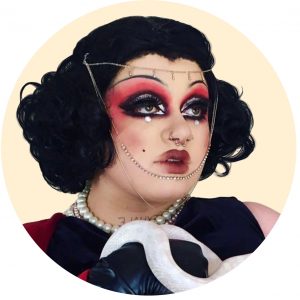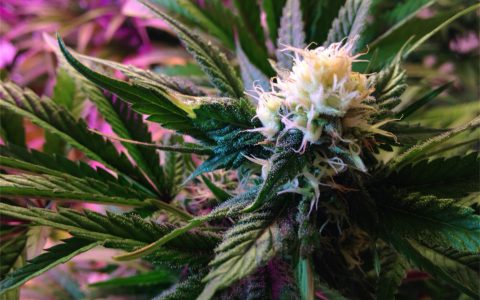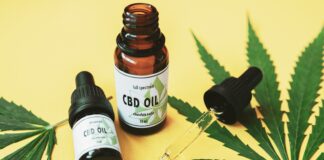Beyond gaining visibility in popular culture, thanks in large part to the reality TV show, RuPaul’s Drag Race, drag has been around for years.
The term “drag” was originally a theater term that refers to performers dressing in clothing typically worn by the opposite sex. Drag performers and the art of drag has long been a political art form with ties to gender, gender performativity, gender fluidity, and of course, good old-fashioned sex.
Throughout the years, drag played out in gay bars and back alleys where performers would comment on everything from pop culture to politics while taking in a fantastic show of pure performance.
For a new generation of drag performers, this fringe art form that so many love and enjoy can bring a lot of low-key stress and anxiety. Securing weekly gigs, making and creating drag looks, and creating new stage acts—it can become a lot. Which is why a lot of performers have started to explore different products and strains available on the market to help boost their creativity, help with chronic pain, and combat performance-related anxiety.
We spoke to three drag performers about their relationship to the plant and how it has changed their drag.
Allysin Chaynes, Toronto ON
 Allysin Chaynes drag career technically started in seventh grade on Halloween, when they dressed up for the very first time. But professionally, they started performing in 2013, in the west end of Toronto, which she explains is the “weirder, more alternative side of drag in the city.”
Allysin Chaynes drag career technically started in seventh grade on Halloween, when they dressed up for the very first time. But professionally, they started performing in 2013, in the west end of Toronto, which she explains is the “weirder, more alternative side of drag in the city.”
In her first performance, she shared the stage with Judy Virago, who became a mentor and friend. Virago invited Chaynes to join her drag family, the House of Filth—an alternative performing arts collective and the rest is history.
Chaynes who describes their drag style as “a touring rockstar with a seventies stoner” turned to medical cannabis to help with anxiety and depression. When she first started performing professionally, Chaynes explained that her anxiety would be at an all-time high before performing.
“I tend to blend cannabis with drag these days, as I think it makes me way better of a performer,” sharing that there seems to be some sort of immediate connection between brain and body that unleashes itself. “I feel so much more of a holistic performer when I’ve been using cannabis. […] It has to do with toning down the anxiety and toning down the voices in your head, […] letting yourself exist in the moment.”
Typically, Chaynes finds herself drawn to sativa strains, noting that Watermelon Haze ‘sponsored’ her summer performances. “That was a really, really great performing weed.” While Chaynes typically smokes joints, she has also up for a nice distillate or a tincture under the tongue. For her, cannabis has been a life-changing explaining, that it has “kept me motivated, and kept me moving.”
Find Sativa Strains Near You
Caeleb Day (AKA Katinka Smirnov), Edmonton AB
 For Caeleb Day, age 21, of Edmonton, becoming a drag performer sort of happened organically. As a professional makeup artist, makeup was mostly about trends and aesthetics until they started painting the faces of other drag performers.
For Caeleb Day, age 21, of Edmonton, becoming a drag performer sort of happened organically. As a professional makeup artist, makeup was mostly about trends and aesthetics until they started painting the faces of other drag performers.
“I started going to Eva (the gay bar in Edmonton) and people started to know me for doing the makeup of other queens.” It wasn’t until January 2016, that Day decided they too wanted to break into the drag world and had their first show at the club.
Debuting Katinka Smirnov on stage however was no small feat, as Day who has been an active user of medical cannabis since the age of 15, has severe anxiety sharing, “I started showing really bad symptoms of paranoia with my anxiety and as I got older, it literally just worsened with every single month.”
Under the advisement of a doctor, Day began to test out a CBD and THC combination oil and upon realizing how effective it was, moved on to smoking extracts. “It has literally made everything so much easier. I personally don’t think that I could perform without it, just because of how bad my paranoia is.”
Day shares that Pink Kush and Girl Scout Cookies were two of the best strains for their anxiety as well as a catalyst for creativity and a motivation-booster. “Sometimes I’ll just sit down, smoke a joint, listen to music, and come up with a fully sketched out concept.”
Day thinks that cannabis can be super helpful for anyone with anxiety but acknowledges that it can be a journey, requiring some guidance, to find what’s right for each individual.
“I use to have such a weird, negative outlook on drugs—specifically weed,” says Day. “But, when I actually went to a doctor who told me the type of weed that I need to smoke, and how, it was such an eye-opening experience. I was like, cannabis is really not terrible, it’s actually useful.”
Find Pink Kush & Girl Scout Cookies Near You
Caitlin Hartlen (AKA Jack Doff), Halifax, NS
 Caitlin Hartlen had been living in Halifax since about 2009 and had become part of the local queer community. A huge part of her weekly outings were the drag shows, one specifically called Five Minutes of Fame, which held an open stage night where anyone could perform.
Caitlin Hartlen had been living in Halifax since about 2009 and had become part of the local queer community. A huge part of her weekly outings were the drag shows, one specifically called Five Minutes of Fame, which held an open stage night where anyone could perform.
Hartlen had always wanted to perform drag but shares, “I didn’t really know if I could, because I wasn’t a gay man who wanted to dress up like a woman, I was a gay woman who wanted to dress up like a man.”
Hartlen explains that drag kings really didn’t have a lot of exposure and it wasn’t until 2016 when she saw a friend performing as a king that she really thought to herself, “Okay, this can be done.”
After Hartlen finally worked up the courage to debut Jack Doff on stage at the opening night of Pride Week in Halifax, she was basically mobbed backstage with other performers asking when Doff would be back to perform again.
Hartlen has been a medical cannabis consumer for years, using the plant to help with her anxiety and permanent muscle and nerve damage in her lower back. Now, she often incorporates cannabis into her post-performance ritual.
“I would go home after a show, get out of my makeup and have a shower or whatever, and then smoke a joint and go to bed because by that point I’m so exhausted I don’t have energy for anything else,” explains Hartlen who often sought out indica strains that are lower in THC and higher in CBD for their back pain.
She finds the process of rolling joints “to be kind of therapeutic in itself” and notes that after smoking a joint she feels a sense of relaxation like her body is in a state of euphoria.
Performing on stage can take a toll on a person mentally, emotionally and physically—so Hartlen relies on having an Indica on hand after a show. “It just chills me out more,” she explains noting that it will “immediately kind of lift the mood, which is a good thing right before you’re heading to sleep to be in a good mood.”














